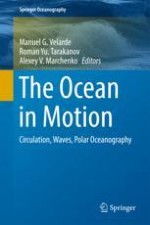2018 | OriginalPaper | Chapter
High-Resolution Observations of Internal Wave Turbulence in the Deep Ocean
Author : Hans van Haren
Published in: The Ocean in Motion
Publisher: Springer International Publishing
Activate our intelligent search to find suitable subject content or patents.
Select sections of text to find matching patents with Artificial Intelligence. powered by
Select sections of text to find additional relevant content using AI-assisted search. powered by
